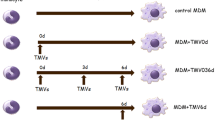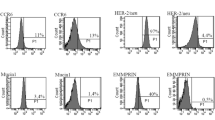Abstract
This study was designed to determine the characteristics of tumour cell-derived microvesicles (TMV) and their interactions with human monocytes. TMV were shed spontaneously by three different human cancer cell lines but their release was significantly increased upon activation of the cells with phorbol 12-myristate 13-acetate (PMA). TMV showed the presence of several surface determinants of tumour cells, e.g. HLA class I, CD29, CD44v7/8, CD51, chemokine receptors (CCR6, CX3CR1), extracellular matrix metalloproteinase inducer (EMMPRIN), epithelial cell adhesion molecule (EpCAM), but their level of expression differed from that on cells they originated from. TMV also carried mRNA for growth factors: vascular endothelial growth factor (VEGF), hepatocyte growth factor (HGF), interleukin-8 (IL-8) and surface determinants (CD44H). TMV were localized at the monocytes surface following their short exposure to TMV, while at later times intracellularly. TMV transferred CCR6 and CD44v7/8 to monocytes, exerted antiapoptotic effect on monocytes and activated AKT kinase (Protein Kinase B). Thus, TMV interact with monocytes, alter their immunophenotype and biological activity. This implicates the novel mechanism by which tumour infiltrating macrophages may be affected by tumour cells not only by a direct cell to cell contact, soluble factors but also by TMV.









Similar content being viewed by others
References
Albanese J, Meterissian S, Kontogiannea M, Dubreuil C, Hand A, Sorba S, Dainiak N (1998) Biologically active Fas antigen and its cognate ligand are expressed on plasma membrane-derived extracellular vesicles. Blood 91:3862–3874
Andreola G, Rivoltini L, Castelli C, Huber V, Perego P, Deho P, Squarcina P, Accornero P, Lozupone F, Lugini L, Stringaro A, Molinari A, Arancia G, Gentile M, Parmiani G, Fais S (2002) Induction of lymphocyte apoptosis by tumor cell secretion of FasL-bearing microvesicles. J Exp Med 195:1303–1316
Bachelder RE, Wendt MA, Fujita N, Tsuruo T, Mercurio AM (2001) The cleavage of Akt/protein kinase B by death receptor signaling is an important event in detachment induced apoptosis. J Biol Chem 276:34702–34707
Baj-Krzyworzeka M, Majka M, Pratico D, Ratajczak J, Vilaire G, Kijowski J, Reca R, Janowska-Wieczorek A, Ratajczak MZ (2002) Platelet-derived microparticles stimulate proliferation, survival, adhesion, and chemotaxis of hematopoietic cells. Exp Hematol 30:450–459
Baran J, Weglarczyk K, Mysiak M, Guzik K, Ernst M, Flad HD, Pryjma J (2001) Fas (CD95)-Fas ligand interactions are responsible for monocyte apoptosis occurring as a result of phagocytosis and killing of Staphylococcus aureus. Infect Immun 69:1287–1297
Barz D, Goppelt M, Szamel M, Schirrmacher V, Resch K (1985) Characterization of cellular and extracellular plasma membrane vesicles from a non-metastasizing lymphoma (Eb) and its metastasizing variant (ESb). Biochim Biophys Acta 814:77–84
Datta SR, Dudek H, Tao X, Masters S, Fu H, Gotoh Y, Greenberg ME (1997) Akt phosphorylation of BAD couples survival signals to the cell-intrinsic death machinery. Cell 91:231–241
Datta SR, Brunet A, Greenberg ME (1999) Cellular survival: a play in three Akts. Genes Dev 13:2905–1927
Dolo V, Adobati E, Canevari S, Picone MA, Vittorelli ML (1995) Membrane vesicles shed into the extracellular medium by human breast carcinoma cells carry tumor-associated surface antigens. Clin Exp Metastasis 13:277–286
Dolo V, Ginestra A, Cassara D, Violini S, Lucania G, Torrisi MR, Nagase H, Canevari S, Pavan A, Vittorelli ML (1998) Selective localization of matrix metalloproteinase 9, beta1 integrins, and human lymphocyte antigen class I molecules on membrane vesicles shed by 8701-BC breast carcinoma cells. Cancer Res 58:4468–4474
Forlow SB, McEver RP, Nollert MU (2000) Leukocyte-leukocyte interactions mediated by platelet microparticles under flow. Blood 95:1317–1323
Friedl P, Maaser K, Klein CE, Niggemann B, Krohne G, Zanker KS (1997) Migration of highly aggressive MV3 melanoma cells in 3-dimensional collagen lattices results in local matric reorganization and shedding of alpha2 and beta1 integrins and CD44. Cancer Res 57:2061–2070
Fritzsching B, Schwer B, Kartenbeck J, Pedal A, Horejsi V, Ott M (2002) Release and intercellular transfer of cell surface CD81 via microparticles. J Immunol 169:5531–5537
Fujimi S, Ogura H, Tanaka H, Koh T, Hosotsubo H, Nakamori Y, Kuwagata Y, Shimazu T, Sugimoto H (2002) Activated polymorphonuclear leukocytes enhance production of leukocyte micropraticles with increased adhesion molecules in patients with sepsis. J Trauma 52:443–448
George JN, Thoi LL, McManus LM, Reimann TA (1982) Isolation of human platelet membrane microparticles from plasma and serum. Blood 60: 834–840
Horstman LL, Jy W, Jimenez JJ, Ahn YS (2004) Endothelial microparticles as markers of endothelial dysfunction. Front Biosci 9:1118–1135
Kim CW, Lee HM, Lee TH, Kang C, Kleinman HK, Gho YS (2002) Extracellular membrane vesicles from tumor cells promote angiogenesis via sphingomyelin. Cancer Res 62:6312–6317
Kim HK, Song KS, Park YS, Kang YH, Lee YJ, Lee KR, Kim HK, Ryu KW, Bae JM, Kim S (2003) Elevated levels of circulating platelet microparticles, VEGF, IL-6 and RANTES in patients with gastric cancer: possible role of a metastasis predictor. Eur J Cancer 39:184–191
Levesque MC, Haynes BF (1996) In vitro culture of human peripheral blood monocytes induces hyaluronan binding and up-regulates monocyte variant CD44 isoform expression. J Immunol 156:1557–1565
Mantovani A, Bottazzi B, Colotta F, Sozzani S, Ruco L (1992) The origin and function of tumor-associated macrophages. Immunol Today 13:265–270
Marhaba R, Bourouba M, Zoller M (2003) CD44v7 interferes with activation – induced cell death by up-regulation of anti apoptotic gene expression. J Leukoc Biol 74:135–148
Mayer C, Maaser K, Daryab N, Zanker KS, Brocker EB, Friedl P (2004) Release of cell fragments by invading melanoma cells. Eur J Cell Biol 83:709–715
Mesri M, Altieri DC (1998) Endothelial cell activation by leukocyte microparticles. J Immunol 161:4382–4387
Mytar B, Siedlar M, Woloszyn M, Collizzi V, Zembala M (2001) Cross-talk between human monocytes and cancer cells during reactive oxygen intermediates generation the essential role of hyaluronan. Int J Cancer 94:727–732
Mytar B, Baran J, Gawlicka M, Ruggiero I, Zembala M (2002) Immunophenotypic changes and induction of apoptosis of monocytes and tumour cells during their interactions in vitro. Anticaner Res 22:2789–2796
Mytar B, Woloszyn M, Szatanek R, Baj-Krzyworzeka M, Siedlar M Ruggiero I, Wieckiewicz J, Zembala M (2003) Tumor cell-induced deactivation of human monocytes. J Leukoc Biol 74:1094–1101
Omoto S, Nomura S, Shouzu a, Nishikawa M, Fukuhara S, Iwasaka T (2002) Detection of monocyte-derived macroparticles in patients with Type II diabetes mellitus. Diabetologia 45:550–555
Pollard JW (2004) Tumour-educated macrophages promote tumour progression and metastasis. Nat Rev Cancer 4:71–78
Reddy SM, Hsiao KH, Abernethy VE, Fan H, Longacre A, Lieberthal W, Rauch J, Koh JS, Levine JS (2002) Phagocytosis of apoptotic cells by macrophages induces novel signaling events leading to cytokine-independent survival and inhibition of proliferation: activation of Akt and inhibition of extracellular signal-regulated kinases 1 and 2. J Immunol 169:702–713
Sabatier F, Roux V, Anfosso F, Camoin L, Sampol J, Dignat-George F (2002) Interaction of endothelial microparticles with monocytic cells in vitro induces tissue factor-dependent procoagulant activity. Blood 99: 3962–3970
Satta N, Toti F, Feugeas O, Bohbot A, Dachary-Prigent J, Eschwege V, Hedman H, Freyssinet JM (1994) Monocyte vesiculation is a possible mechanism for dissemination of membrane-associated procoagulant activities and adhesion molecules after stimulation by lipopolysaccharide. J Immunol 153:3245–3255
Scholz T, Temmler U, Krause S, Heptinstall S, Losche W (2002) Transfer of tissue factor from platelets to monocytes: role of platelet-derived microvesicles and CD62P. Thromb Haemost 66:1033–1038
Seiter S, Schmidt DS, Zoller M (2000) The CD44 variant isoforms CD44v6 and CD44v7 are expressed by distinct leukocyte subpopulations and exert non-overlapping functional activities. Int Immunol 12:37–49
Shedden K, Xie XT, Chandaroy P, Chang YT, Rosania GR (2003) Expulsion of small molecules in vesicles shed by cancer cells: association with gene expression and chemosensitivity profiles. Cancer Res 63:4331–4337
Sidhu SS, Mengistab AT, Tauscher AN, LaVail J, Basbaum C (2004) The microvesicle as a vehicle for EMMPRIN in tumor-stromal interactions. Oncogene 29:956–963
Taylor DD, Gercel-Taylor C (2005) Tumour-derived exosomes and their role in cancer-associated T-cell signaling defects. Br J Cancer 92:305–311
Van Amersfoort ES, Van Strijp JA (1994) Evaluation of a flow cytometric fluorescence quenching assay of phagocytosis of sensitized sheep erythrocytes by polymorphonuclear leukocytes. Cytometry 17:294–301
Wang HQ, Quan T, He T, Franke TF, Voorhees JJ, Fisher GJ (2003) Epidermal growth factor receptor dependent, NFkB independent activation of the phosphatidyloinositol 3 kinase/Akt pathway inhibits ultraviolet irradiation induced caspase −3, −8, and 9 in human keratinocytes. J Biol Chem 278: 45737–45745
Weiss JM, Renkl AC, Ahrens T, Moll J, Mai BH, Denfeld RW, Schopf E, Ponta H, Herrlich P, Simon JC (1998) Activation-dependent modulation of hyaluronate-receptor expression and of hyaluronate-avidity by human monocytes. J Invest Dermatol 111:227–232
Acknowledgements
This study was supported by the State Committee for Scientific Research (grant no. 3P05A 057 22 and PBZ-KBN-091/P05/2003). We thank Ms B. Hajto, I.Ruggiero and M. Wołoszyn for skillful technical assistance.
Author information
Authors and Affiliations
Corresponding author
Rights and permissions
About this article
Cite this article
Baj-Krzyworzeka, M., Szatanek, R., Węglarczyk, K. et al. Tumour-derived microvesicles carry several surface determinants and mRNA of tumour cells and transfer some of these determinants to monocytes. Cancer Immunol Immunother 55, 808–818 (2006). https://doi.org/10.1007/s00262-005-0075-9
Received:
Accepted:
Published:
Issue Date:
DOI: https://doi.org/10.1007/s00262-005-0075-9




